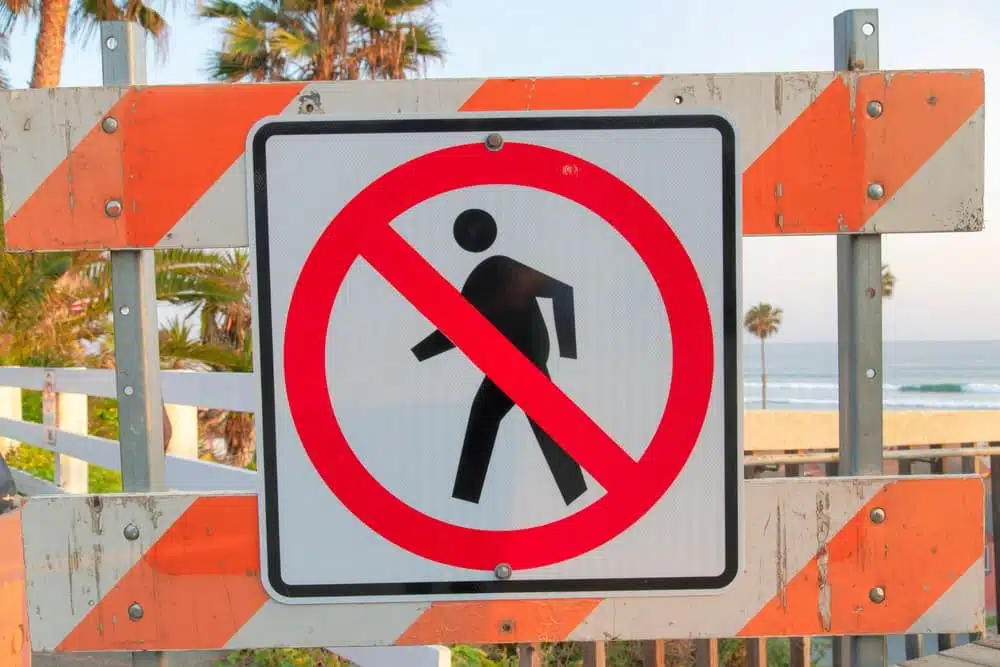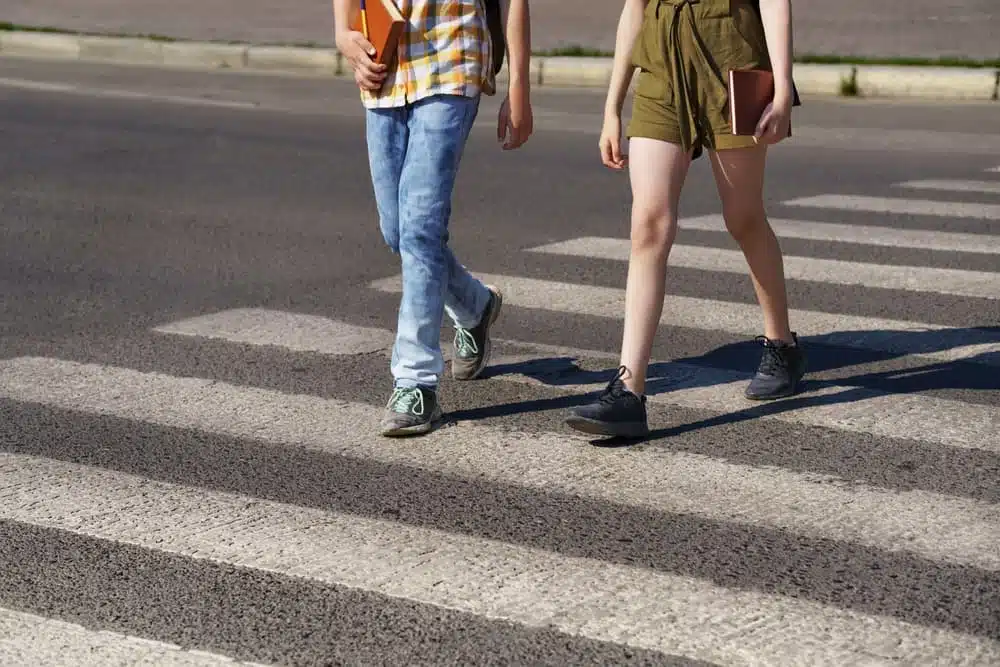
When it comes to traffic laws, jaywalking is one of the most commonly misunderstood offenses. Many people believe that as long as they are not crossing at a designated crosswalk, they do not have the right of way, and drivers have no obligation to yield to them.
However, the reality is more complex. While jaywalking is indeed illegal in most jurisdictions, drivers still have a duty of care to avoid colliding with pedestrians, even those crossing the road unlawfully.
If you are injured in a pedestrian accident, even if you may have been jaywalking, you should consult to a seasoned pedestrian accident attorney.
What Is Jaywalking?
Jaywalking refers to crossing a roadway illegally as a pedestrian.
The exact definition varies by jurisdiction but generally includes:
- Crossing outside of a marked crosswalk at an intersection where crosswalks exist
- Crossing midblock where no crosswalk exists, unless crossing is permitted
- Crossing against a pedestrian control signal (e.g. a red “don’t walk” sign)
- Walking in the roadway unlawfully
Most places make jaywalking an infraction or violation punishable by a fine, although enforcement tends to be lax. Law enforcement will often only ticket jaywalkers if they significantly impede traffic or place themselves or others in danger.
When Do Pedestrians Have the Right of Way?
Pedestrians crossing in a marked crosswalk or at an intersection with no marked crosswalks generally have the right of way over vehicles. Drivers must yield to pedestrians in these situations. The only exception is when the pedestrian crosses against a pedestrian control signal.
Vehicles typically have the right of way outside of marked and unmarked crosswalks. However, this does not mean drivers have no responsibility to avoid colliding with jaywalking pedestrians. More on this later.
Pedestrian Responsibilities
While drivers have a greater duty of care as the operators of dangerous machinery, pedestrians also have certain responsibilities to protect their own safety and avoid impeding traffic.
These responsibilities include:
- Obeying pedestrian control signals and only entering crosswalks when permitted
- Not suddenly leaving a curb or other place of safety and walking/running into the path of a vehicle
- Using crosswalks when available and not crossing midblock if adjacent intersections have marked crosswalks
- Yielding the right of way to vehicles when crossing outside a marked or unmarked crosswalk
Drivers still must do everything possible to avoid striking pedestrians even when they fail to meet these responsibilities. However, pedestrians can bear partial liability if their negligence contributes to a collision.
Driver Responsibilities
Drivers have a duty of care to operate their vehicles safely and avoid endangering pedestrians, other motorists, and property.
When it comes to pedestrians, key driver responsibilities include:
- Yielding the right of way to pedestrians lawfully crossing in a marked or unmarked crosswalk
- Exercising due care to avoid colliding with pedestrians on any part of the roadway
- Taking extra precautions and traveling at a reduced speed in areas where pedestrians are likely present, such as urban areas, school zones, parks, etc.
- Being prepared to yield to pedestrians even when they do not have the right of way, especially children, seniors, and visibly intoxicated individuals
- Never passing vehicles that are stopped at a crosswalk, as they may be stopped for pedestrians.
Failure to meet these responsibilities, resulting in injury to a pedestrian, may constitute negligence and open a driver up to civil liability and/or criminal charges.
Jaywalking and Fault
One of the most common questions in pedestrian accident cases is how fault is determined when the pedestrian is jaywalking. As noted above, while jaywalkers do not have the right of way, drivers can still bear fault for hitting them in many circumstances.
Generally speaking, drivers have a duty to avoid colliding with pedestrians regardless of whether the pedestrian jaywalked. If a pedestrian is already in the road, even unlawfully, an approaching driver must yield to them if possible. Failure to do so could put the driver primarily at fault.
However, if a pedestrian suddenly leaves the curb or a place of safety and runs out into traffic at a point where a driver cannot reasonably yield in time, the pedestrian would likely bear primary responsibility. However, the driver may share some liability if they speed, drive distracted, or otherwise not exercise due care.
Many pedestrian accident cases involve a combination of jaywalking and driver negligence. Comparative or contributory negligence rules apply to apportion fault between the parties in these situations.
A few key points:
- In contributory negligence states (there are only a few in the U.S., including North Carolina and Maryland), an injured plaintiff found even 1% at fault recovers nothing. Jaywalking could bar recovery.
- In pure comparative negligence states like New York, an injured plaintiff’s damages are reduced in proportion to their share of fault. A jaywalking pedestrian who is 30% at fault would have their damages reduced by 30%.
- In modified comparative negligence states like New Jersey and Pennsylvania, plaintiffs can recover if they are less than 50% or 51% at fault, with damages reduced accordingly. Slight jaywalker negligence may reduce damages; major jaywalker fault could bar recovery entirely.
Because pedestrians are so vulnerable compared to vehicles, drivers are held to a high standard to watch for and avoid pedestrians. A jaywalking pedestrian is not fair game and almost always has some legal protection.
Can Someone Unknowingly Jaywalk?
Yes. While jaywalking is typically an intentional act, pedestrians can jaywalk accidentally.
This can happen due to:
- Unfamiliarity with the area: Pedestrians new to a particular region or city may not know the local jaywalking laws or the location of designated crosswalks. This lack of familiarity can lead to accidental jaywalking.
- Poorly marked crosswalks: In some cases, crosswalks may be poorly marked or maintained, making it difficult for pedestrians to identify where they are supposed to cross the street. This can result in pedestrians accidentally crossing outside of a designated crosswalk.
- Distractions: Pedestrians distracted by their phones, conversations, or other factors may not pay attention to their surroundings and may accidentally cross the street without realizing they are jaywalking.
- Confusion in complex intersections: Some intersections, particularly in busy urban areas, can be complex and confusing for pedestrians. Multiple crosswalks, traffic signals, and turning vehicles can make it challenging for pedestrians to navigate the intersection and accidentally lead to jaywalking.
- Following the crowd: In busy areas, pedestrians may see others crossing the street outside a designated crosswalk and follow suit without realizing they are jaywalking.
Regardless of whether a pedestrian intentionally or accidentally jaywalks, drivers must exercise reasonable care and avoid collisions when possible. If a driver’s negligence contributed to the accident, they might still need to pay for the pedestrian’s injuries and damages.
The Importance of Consulting a Lawyer after a Pedestrian Accident
After a pedestrian accident, even if you were jaywalking, consult an experienced personal injury lawyer before accepting any settlement offer from an insurance company.
Here’s why:
- Protecting your rights: Insurance companies are businesses and may minimize the amount they pay in claims. A lawyer can help protect your rights and ensure you receive fair compensation for your injuries and losses.
- Evaluating the settlement offer: An initial settlement offer from an insurance company may not fully account for all your damages, such as future medical expenses, lost wages, pain and suffering, and other long-term consequences of the accident. A lawyer can evaluate the offer and determine if it is adequate given the specific circumstances of your case.
- Navigating comparative negligence laws: In states like New Jersey and Pennsylvania, where modified comparative negligence laws apply, the amount of damages you can recover may be reduced if you are partially at fault for the accident due to jaywalking. However, this does not mean you cannot recover any compensation. A lawyer can explain how these laws apply to your case and work to maximize your recovery.
- Investigating the accident: A lawyer can thoroughly investigate the accident, gather evidence, and consult experts to build a strong case on your behalf. This may uncover factors that reduce your liability or increase the driver’s fault, such as speeding, distracted driving, or failure to yield.
- Negotiating with the insurance company: A lawyer can handle communication and negotiation with the insurance company on your behalf. They use their knowledge and experience to advocate for a higher settlement or take your case to trial if necessary.
Remember, once you accept a settlement offer, you typically waive your right to pursue further compensation related to the accident. Therefore, never accept an offer without first consulting a lawyer who can advise you on whether it is fair and in your best interests.
Compensation Available in a Pedestrian Accident Claim
Pedestrian accident victims and their families may be entitled to compensation for various types of damages, depending on the specific circumstances of the case.
If a pedestrian accident injured you or a loved one, you may recover compensation for:
- Medical expenses: This includes all medical costs related to the accident, such as emergency room visits, hospital stays, surgeries, medications, physical therapy, and any necessary ongoing treatment. In cases of severe injuries, compensation may also cover future anticipated medical expenses.
- Lost wages or income: If the accident causes you to miss work or lose earning capacity due to your injuries, you may be entitled to compensation for lost wages, bonuses, and benefits. In cases of permanent disability or impairment, you may also recover compensation for future lost earning potential.
- Pain and suffering: Pedestrian accident victims may be entitled to compensation for the physical pain, emotional distress, and mental anguish caused by the accident and their injuries. This can include compensation for loss of enjoyment of life, anxiety, depression, and other psychological impacts.
- Permanent disability or disfigurement: If the accident results in permanent disabilities, scarring, or disfigurement, victims may be entitled to additional compensation for the long-term impact on their quality of life and future opportunities.
- Property damage: If any personal property, such as clothing, electronics, or other items, was damaged in the accident, you may be entitled to compensation for repair or replacement costs.
- Wrongful death: In tragic cases where a pedestrian accident results in the death of the victim, their surviving family members may be entitled to compensation through a wrongful death claim. This can include damages for funeral and burial expenses, loss of financial support, loss of companionship, and the emotional distress of losing a loved one.
The specific damages available and the amount of compensation will depend on the severity of the injuries, the extent of fault attributed to each party, and the applicable laws in the jurisdiction where the accident occurred. An experienced pedestrian accident lawyer can help assess your case, identify all potential damages, and work to secure the maximum compensation possible for your losses.
Every case is unique, and the availability and amount of damages will depend on the specific facts and circumstances involved. A qualified attorney will explain your legal rights and options after a pedestrian accident.
Contact a Pedestrian Accident Lawyer From Rothenberg Law Firm, LLP
While jaywalking is illegal, jaywalkers do not forfeit all right-of-way privileges and legal protections. Drivers have a duty of care to avoid colliding with pedestrians in the roadway, even when they are crossing illegally. Pedestrians also have the responsibility to cross safely and avoid impeding traffic.
Fault in pedestrian accidents involving jaywalking depends on the specific circumstances, the actions of both the pedestrian and driver and the applicable negligence laws of the state. In most cases, drivers have a greater duty of care and bear most of the fault if they strike a pedestrian unlawfully crossing the road. However, pedestrian negligence can reduce or bar their ability to recover damages.
If you are injured in a pedestrian accident, even if you may have been jaywalking, you should speak to an experienced personal injury lawyer. A lawyer from Rothenberg Law Firm LLP can investigate the accident, determine fault, and help protect your legal rights. Contact us today at (800) 624-8888 or through our online form for a free consultation.




